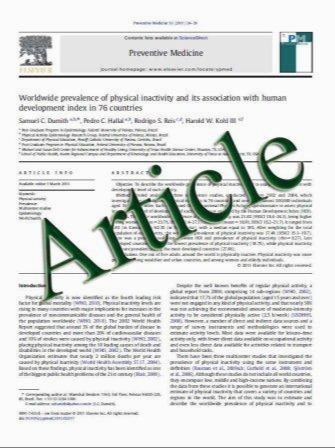Economic evaluation of dose–response resistance training in older women: a cost-effectiveness and cost-utility analysis
- نوع فایل : کتاب
- زبان : انگلیسی
- مؤلف : J. C. Davis & C. A. Marra & M. C. Robertson & K. M. Khan & M. Najafzadeh & M. C. Ashe & T. Liu-Ambrose
- چاپ و سال / کشور: 2010
Description
Summary We estimated the incremental cost-effectiveness of a once-weekly or twice-weekly resistance training intervention compared with balance and tone classes in terms of falls prevented and quality-adjusted life years (QALYs) gained. Both resistance training interventions were more likely to save health care resource money and offer better health outcomes for falls prevention than balance and tone classes. Introduction This study aims to estimate the incremental cost-effectiveness and cost-utility of a once-weekly or twice-weekly resistance training intervention compared with twice-weekly balance and tone classes in terms of falls prevented and QALYs gained. Methods Economic evaluation was conducted concurrently with a three-arm randomized controlled trial including 155 community-dwelling women aged 65 to 75 years, Mini Mental State Examination .24, and visual acuity 20/40 or better. Participants received the once-weekly resistance training (n=54), the twice-weekly resistance training (n= 51) or the twice-weekly balance and tone (the comparator) classes (n=50) for 1 year. Measurements included the number of falls for each participant, healthcare resource utilization, and associated costs over 9 months; health status was assessed using the EQ-5D and SF-6D to calculate QALYs. Results Based on the point estimates from our base case analysis, we found that both once- and twice-weekly resistance training groups were less costly (p<0.05) and more effective than twice-weekly balance and tone classes. The incremental QALYs assessed using the SF-6D were 0.003 for both the once- and twice-weekly resistance training groups, compared with the twice-weekly balance and tone classes. The incremental QALYs assessed using the EQ-5D were 0.084 for the once-weekly and 0.179 for the twice-weekly resistance training groups, respectively, compared with the twice-weekly balance and tone classes. Conclusions An individually tailored resistance training intervention delivered once or twice weekly provided better value for money for falls prevention than balance and tone classes.
Osteoporos Int (2011) 22:1355–1366 DOI 10.1007/s00198-010-1356-5 Received: 16 February 2010 / Accepted: 14 June 2010 / Published online: 4 August 2010


